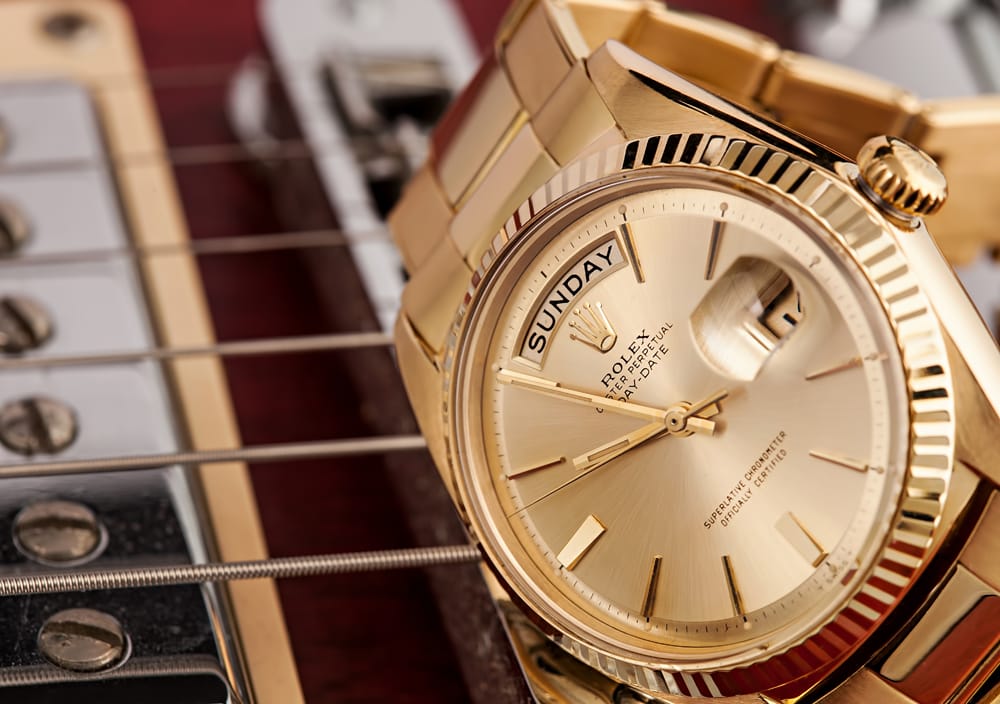This week’s vintage spotlight is on a member of the Rolex Day-Date collection – specifically, a reference 1803 that has been photographed on a Gibson Les Paul guitar. A classic watch with a classic guitar, these two are quite the pair, aren’t they? But hey, eyes back here on the dial! Let’s take a close look at this unique, early example of this world-famous watch and discover more about the Rolex Day-Date 1803.
Table of Contents:
Rolex Day-Date 1803
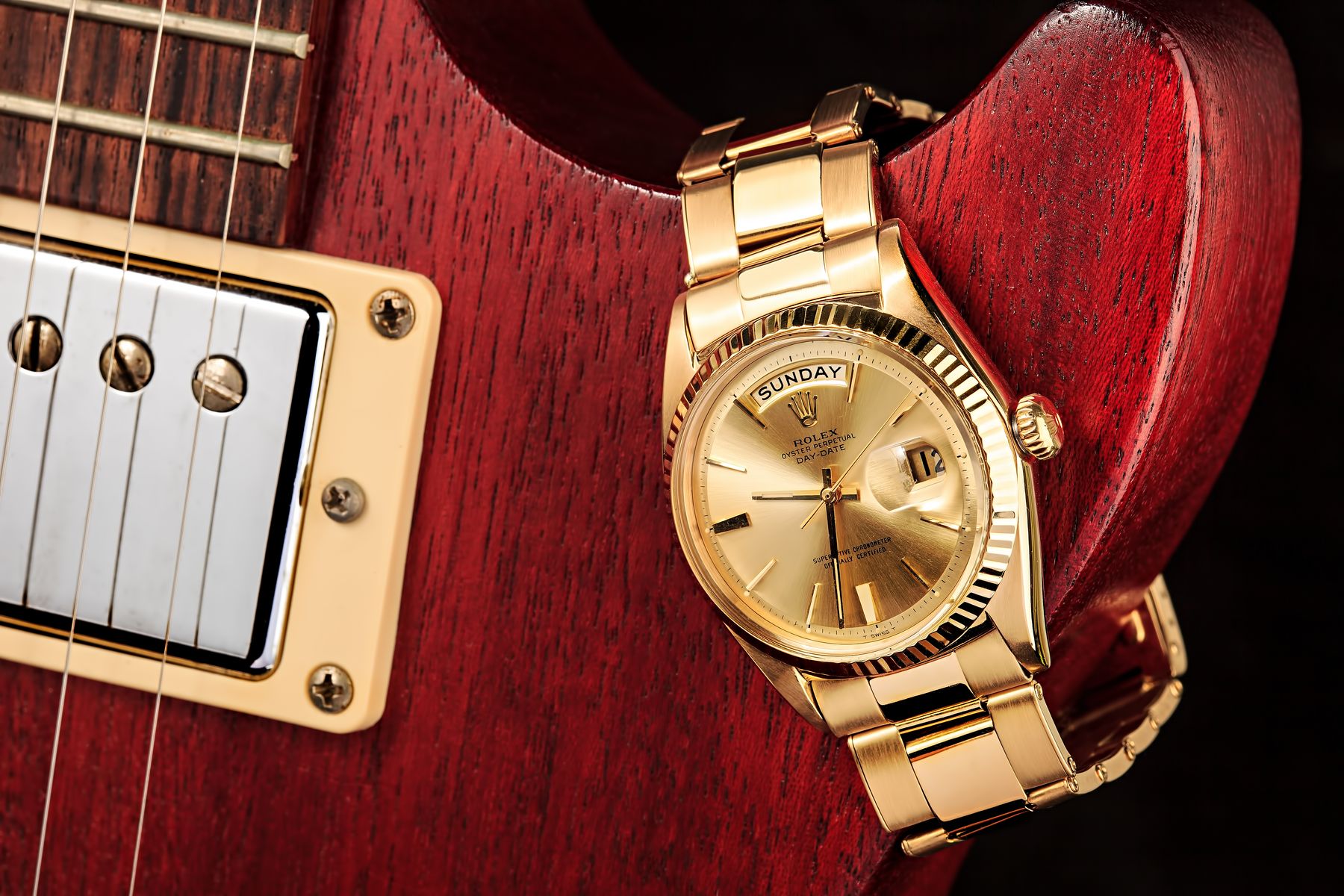
Day-Date ref. 1803 Key Features
- Reference Number: 1803
- Production Years: 1958 – 1977 (Approx.)
- Materials: 18k Gold (Yellow, White, or Rose)
- Functions: Time w/ Running Seconds, Date Display, Day Indicator
- Dial: Multiple Options Available
- Luminous Material: Radium or Tritium
- Bezel: Fixed, 18k Gold, Fluted Style
- Crystal: Acrylic (Flat w/ Cyclops Lens)
- Movement: Rolex Caliber 1555 or Caliber 1556
- Strap/Bracelet: Oyster or President Bracelet
- Approx Price: $15,000 – $100,000+ (Pre-Owned)
Click here to read our Ultimate Buying Guide on the Rolex Day-Date.
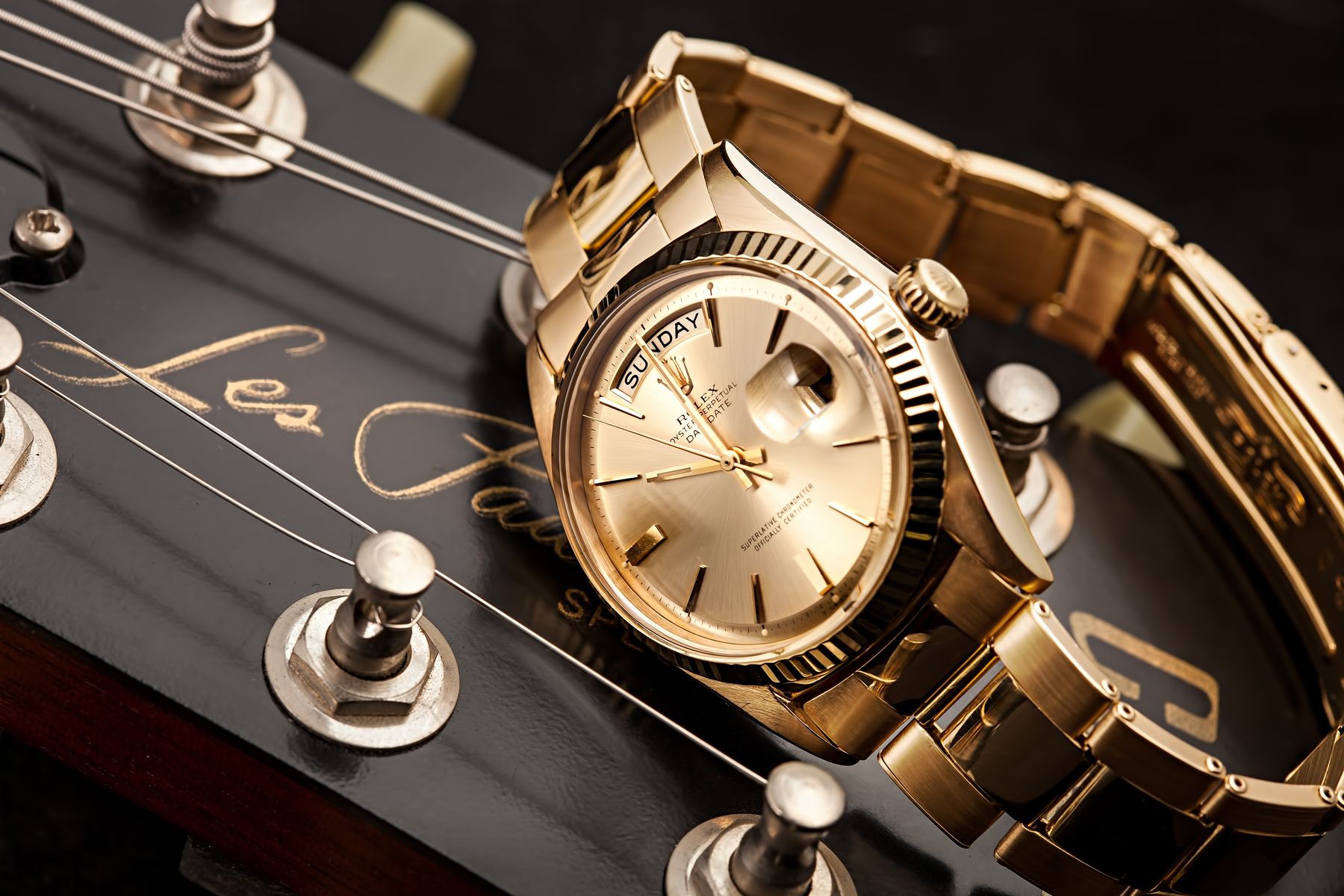
The History of the Rolex Day-Date Collection
The Rolex Day-Date’s legacy began in 1956, with the first references being produced within the series being the 6510 and 6511. Both of these initial models featured the now-iconic President bracelet, a fluted bezel, and a 36mm Oyster case. These references were the first watches in the world to display both the date of the month and the day of the week, with the day spelled out fully through a window on the dial. These initial models also sported Rolex’s patented waterproof Oyster case, exclusively forged out of either gold or platinum, along with a self-winding Perpetual movement.
The first generation set the wheels in motion not only for the iconic ref. 1803, but the rest of the entire Day-Date collection, which would go on to include a wide range of dial colors, new precious metals, updated movements, and even new bracelets.
Rolex Day-Date Timeline
- 1956: Introduction of the Rolex Day-Date collection
- 1958: 180x Series – cal. 1555, later cal. 1556
- 1977: 180xx Series – cal. 3055
- 1977: OysterQuartz Series – cal. 5055, later cal. 5355
- 1988: 182xx Series – cal. 3155
- 2000: 118xxx Series – cal. 3155
- 2008: Day-Date II with 41mm case – cal. 3156
- 2015: Day-Date 40 – cal. 3255
- 2019: 1282xx Series – cal. 3255
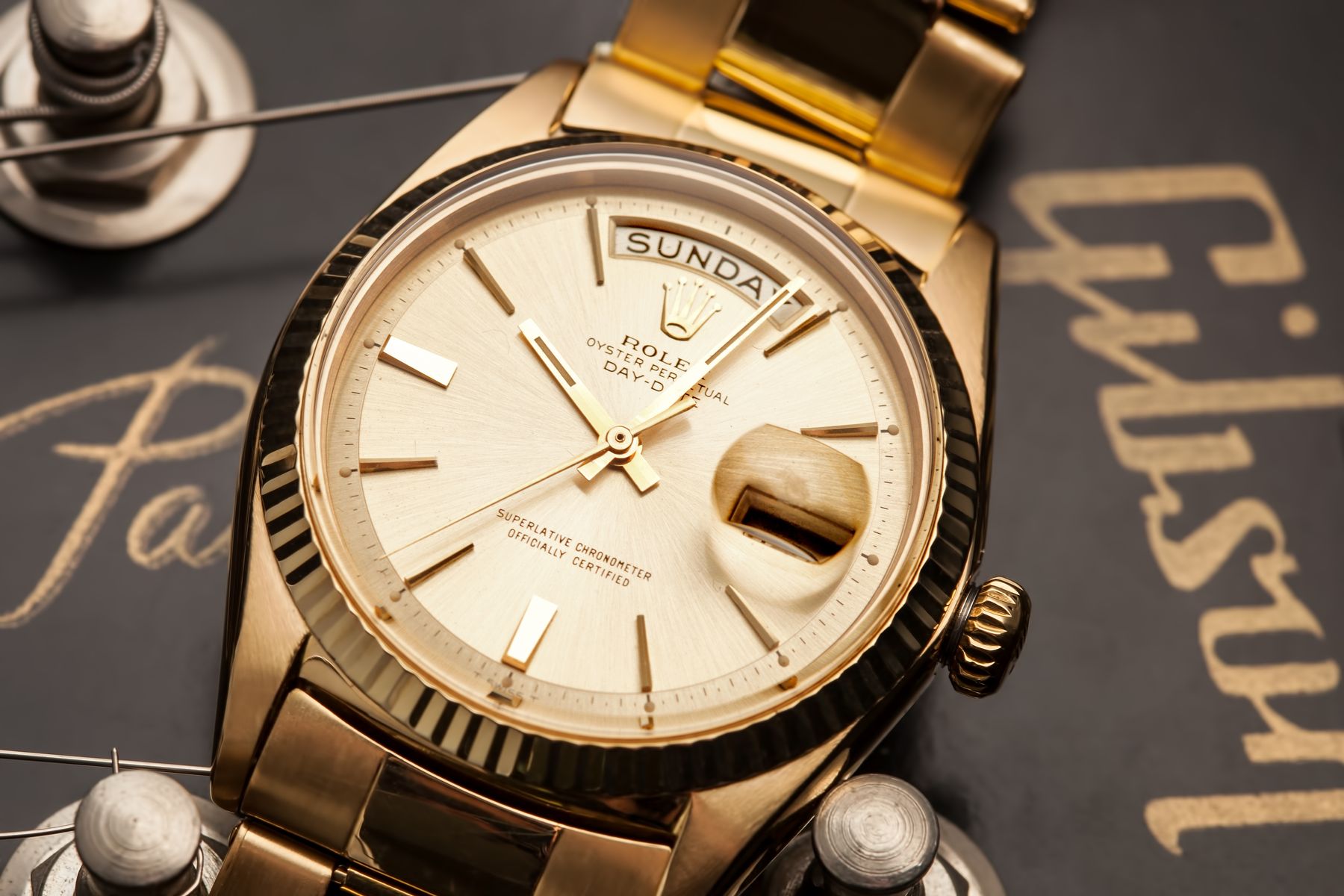
About the Rolex Day-Date 1803
First released in 1956, the Rolex Day-Date was the first wristwatch in the world to display the date and the day of the week spelled out in-full in a window on the dial. And just a few years later, Rolex would introduce us to the ref. 1803, one of the very earliest Rolex Day-Date watches ever released. While the Day-Date – also known as the “President” for its ties to world leaders – would continue to be produced until today, there are a slew of unique features of the ref. 1803 that set it apart.
One of the most notable characteristics is the acrylic crystal that was fitted to the ref. 1803, as all subsequent generations of the Day-Date featured sapphire crystals and today, Rolex exclusively uses synthetic sapphire for its watches. Look closely and you’ll also notice that one of the other unique features is the “pie pan” dials of the Day-Date 1803 – a unique dial shape with a distinct vintage flare, where the outer edge angles downwards, giving the dial the shape of an inverted pie pan. The Rolex Day-Date ref. 1803 was the last model to boast this dial, but do note that the two previous models from the 1950s also featured pie-pan dials.
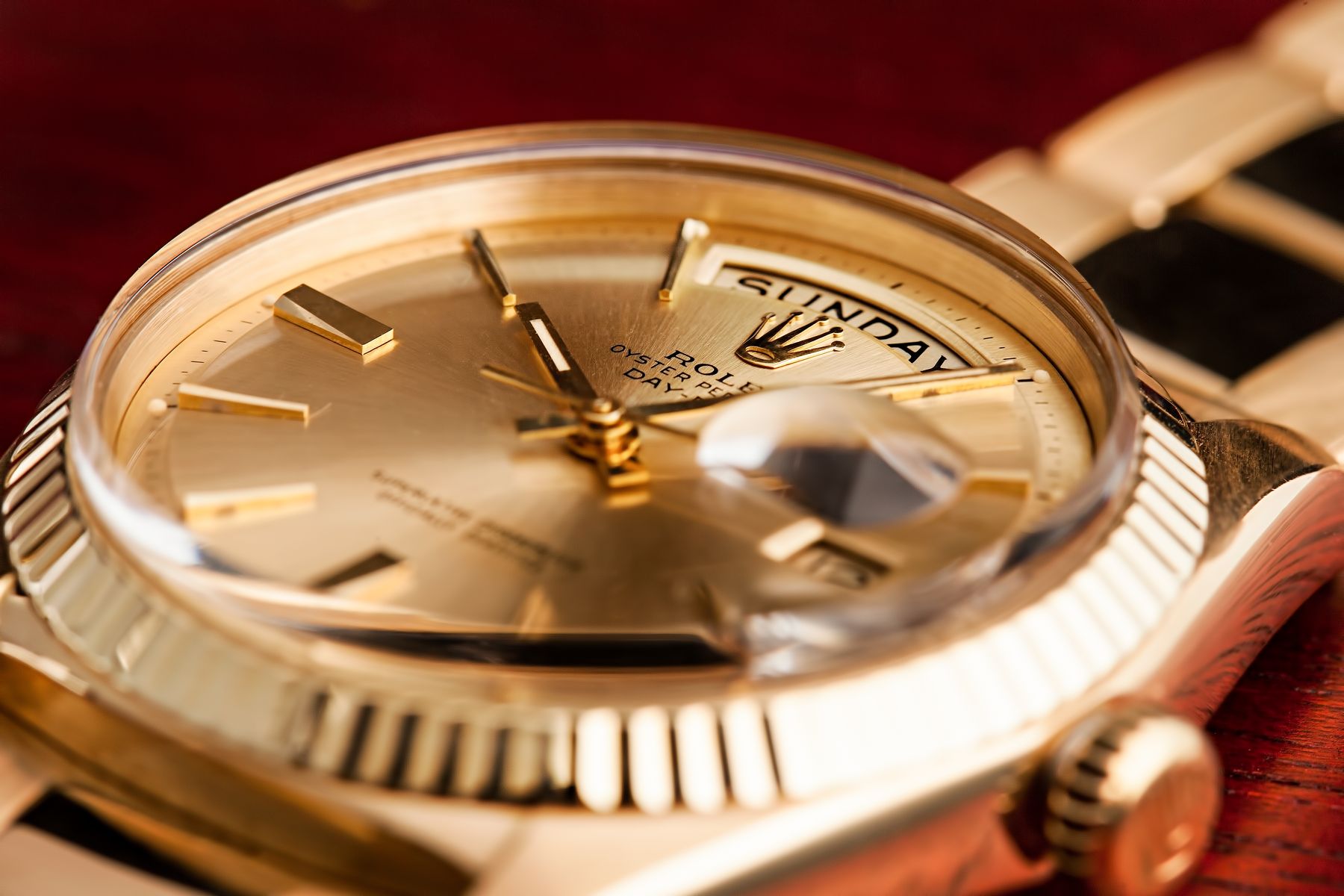
Rolex 1803 Bracelets and Movements
Clocking in at 36mm, the ref. 1803 has the same case diameter as the modern Day-Date watches that are produced today. But looking at this specific reference here, you’ll notice something quite important is missing from this iconic watch. The famous five-link ‘President’ bracelet (which is where the watch gets its nickname) is not present, and in its place is a traditional rivet-style Oyster bracelet in 18k yellow gold.
The 18k gold Oyster bracelets and President bracelets fitted to Rolex Day-Date 1803 watches all feature hollow links, unlike the modern versions that are completely solid. It wasn’t until much later that Rolex would update the model to feature a solid bracelet, and this drastically changed both the weight and the way the watch feels on your wrist. This is actually a great way to tell if you’re slipping on a vintage Rolex, as it will often have a noticeably lighter bracelet design.
Ticking inside the reference 1803 is the caliber 1555 movement with a free-sprung Micro-Stella balance, which would later be updated to the higher-frequency Caliber 1556 in the mid 1960s. With that in mind, neither movement fitted to the Rolex Day-Date 1803 includes a quickset feature for either the date or the day, meaning that they cannot be set independently from the time, and the hands must be advanced past midnight in order to change the calendar displays.
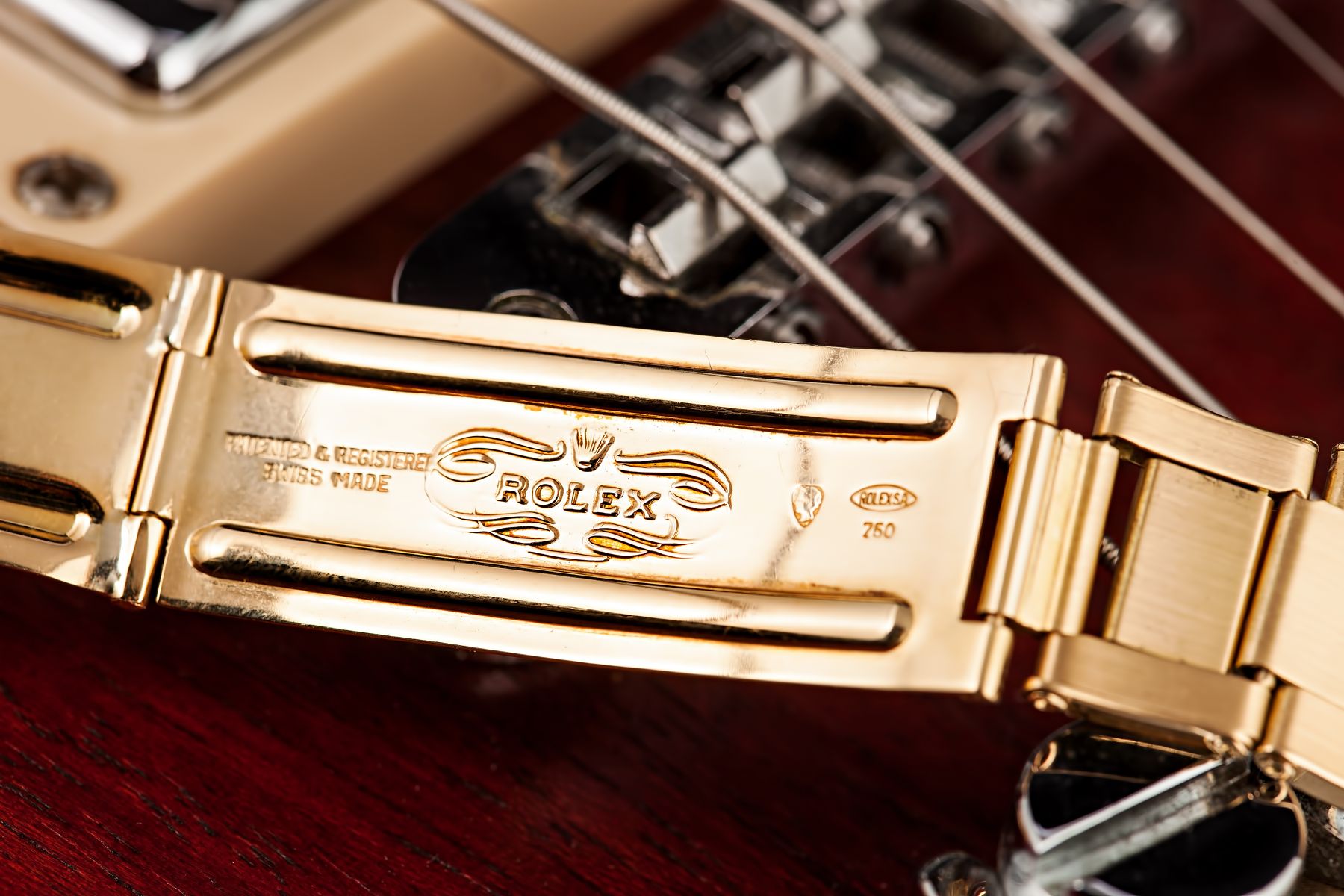
Laying the Groundwork for Future Models
After the introduction of the ref. 1803, some technological changes were made over the next few years, including the addition of the “hack” feature around 1972. The hack feature allowed the seconds hand to be stopped when the crown is pulled out to set the time. The later “quickset” feature, introduced with caliber 3055 on the subsequent generation of the Day-Date in the late 1970s, allowed the wearer to simply pull the crown out halfway and change the date display without also adjusting the time.
The inclusion of sapphire crystal was another great advance for the Day-Date that came with the generation that followed, making the reference 1803 the last Rolex Day-Date model to feature a vintage acrylic crystal. The updated sapphire crystal added to the durability of the watch and offers significantly greater scratch-resistance, but its flat glossy surface creates a much more modern overall aesthetic.
The Rolex Day-Date 1803 is the quintessential vintage example of the brand’s flagship watch. While it was not the very first Day-Date model, the reference 1803 is often the first model that comes to mind when someone thinks of a vintage gold Rolex, and as it was the very last model to feature an acrylic crystal, a pie-pan dial, and a non-quickset movement, it offers an inherently retro appeal that simply doesn’t exist on modern watches.
